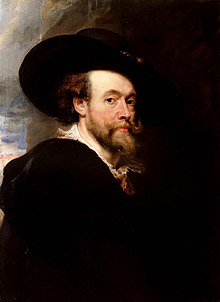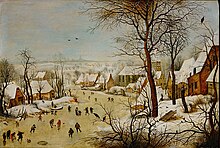Art of Belgium
| Part ofa serieson the |
| Culture of Belgium |
|---|
 |
| History |
| People |
| Languages |
| Mythologyandfolklore |
| Cuisine |
| Religion |
| Art |
| Music |
| Sport |
Despite its size, Belgium has a long and distinguished artistic tradition that goes back to theMiddle Ages,considerably pre-dating the foundation of the current state in 1830. Art from the areas making up modern Belgium is called in EnglishNetherlandishup to the separation with theNetherlandsfrom 1570 on, andFlemishuntil the 18th century.
Important monasteries in Belgium were centres of production inCarolingian artandOttonian art,and later the area producingRomanesqueMosan artis now largely in Belgium.Flandersbecame one of the richest areas in Europe in the later Middle Ages andEarly Netherlandish paintingproduced work for both the wealthy townspeople as well as the courtiers of theDuke of Burgundy.
In the RenaissanceAntwerp Mannerismwas an early attempt by Flemish artists to respond toItalian Renaissance art,withRomanisma later phase.Dutch and Flemish Renaissance paintingculminated in the work ofPieter Bruegel the Elderin one direction, and the Flemish contribution toNorthern Mannerismin a very different one.Flemish Baroque paintingis dominated by the figure ofRubens,though like his pupilAnthony van Dyck,he spent much of his career abroad. There was also a great development of specialized genres in painting, paralleling those inDutch Golden Age paintingto the north, but with many differences.
History of Belgian art
[edit]| History ofDutchandFlemishpainting |
|---|
| Periods |
|
| Lists |
Medieval art
[edit]Mosan artis a regional style ofRomanesque artfrom the valleys of theMeusein present-day Wallonia, and theRhineland,with manuscript illumination, metalwork, and enamel work from the 11th, 12th and 13th centuries. Among them the masterpiece ofRenier de Huyand perhaps of the whole Mosan artBaptismal font at St Bartholomew's Church, Liège. The architecture of Romanesque churches of theWalloon countryis also named Mosan, for example theCollegiate Church of Saint GertrudeinNivelles,and the churches ofWahaandHastière,Dinant.Ornamental brasswareis also a part of Mosan art andHugo d'OigniesandNicholas of Verdunimportant metalworkers. The Mosan Art reliquary shrines in are important phenomenon of Mosan art.
Early Modern art
[edit]
During the so-calledNorthern Renaissance,Belgium experienced an artistic boom, spawning the immensely popularBaroque Flemish schoolof painting. The cities ofBrugesandAntwerp,some of the richest in the region, became artistic centres during the period.
The artistPeter Paul Rubenspainted in Belgium between 1609-1621, working for many royal patrons from his studio inAntwerp.Rubens' house in Antwerp, theRubenshuis,is now a museum.
Anthony van Dyck,celebrated for his painting of British court, includingCharles I,was born in Antwerp.
Flemish artwas not confined to the boundaries of modern Flanders and several leading artists came from or worked in areas in which langues d'oïl were spoken, from the region of modern Wallonia, e.g.Robert Campin,Rogier van der Weyden(Rogier de la Pasture) andJacques Daret.Joachim PatinirHenri Blèsare generally calledmosanpainters.Lambert Lombard(Liège,1505 – 1566) was aRenaissancepainter, architect and theorist for thePrince-Bishopric of Liège.Gérard de Lairesse,Bertholet Flemallewere also important painters in the Prince-Bishopric of Liège.
The Brueghel Dynasty
[edit]
- See alsoBruegel Family
Flemish genre painting is strongly tied to the traditions ofPieter Bruegel the Elderand was a style that continued directly into the 17th century through copies and new compositions made by his sonsPieter Brueghel the YoungerandJan Brueghel the Elder.Many of these are kermis paintings and scenes of peasants partaking other outdoor enjoyments viewed from an elevated viewpoint.
Belgian art in the 19th-20th centuries
[edit]Neoclassicism
[edit]In the 18th century painting in the Southern Low Countries became increasingly focused on France. Many Flemish and Walloon painters studied in Paris and adopted the new neoclassical style en vogue in the last decades of the 18th century. The Bruges painterJoseph-Benoît Suvéemade a career in the French capital where he was a rival ofJacques-Louis David. The latter settled in Brussels after the fall of Napoleon. Their major followers in Belgium (then part of the United Kingdom of the Netherlands) whereJoseph Denis OdevaereandFrançois-Joseph Navez.
Impressionism and neo-impressionism
[edit]Originating in France,Impressionismwas also adopted by Belgian artists.Emile Clausis the most well known representative of 'Luminism', an art movement inspired by Impressionist plein-air painting. The young avant-garde painterJames Ensorexperimented briefly with Impressionism but soon found his very own style. Painters of his generation were more inspired by frenchPointillism,most notably by Seurat and Signac. The youngHenry Van de Veldemade a few works in a pure pointillist style but was also deeply influenced byVincent van Gogh.Anna Boch,Eugène Boch(a close friend ofVincent van Gogh),Georges LemmenandThéo van Rysselberghewere all influential Belgian neo-impressionist painters.
Belgian Surrealism
[edit]Surrealismdeveloped in Belgium during the inter-war period. The best-known Belgian surrealist,René Magritte,exhibited in 1927 for the first time.
Sculpture
[edit]
Jacques du Broeucqwas a sculptor of the 16th century, known for his religious scenes and as the teacher of the famous Italian late-renaissance sculptorGiambologna,who was himself born inFlanders.
Constantin Meunierwas an influential Belgian sculptor of the late 19th-early 20th century, known for his figures, which unusually, often depict industrial workers. Meunier's work was very popular around Europe, coinciding with the rise of the politicalLabour movementin the late 19th century.
George Grard(1901 — 1984) was a Walloon sculptor, known above all for his representations of the female, in the manner ofPierre RenoirandAristide Maillol,modelled in clay or plaster, and cast in bronze. Working inLiègetoo,Jean Del Cour,the sculptor of the Virgin inVinâve d'Isle,Léon Mignonthe sculptor ofLi Tore,andLouis Jéhotteknown for his statue of the Frankish emperorCharlemagne.
Architecture
[edit]
Belgian architects had been at the forefront of theNeoclassical architecturemovement between the mid 18th and 20th centuries. The styleenjoyed great popularity in Belgiumand several neoclassical masterpieces, includingGembloux Abbeyand theChâteau de Seneffesurvive.
In the last quarter of the 19th century, the Belgian architect and furniture designerGustave Serrurier-Bovy[1]is credited (along with Belgian architectsPaul Hankar,Victor HortaandHenry van de Velde) with creating theArt Nouveaustyle, coined as a style inParisby Bing.[2]
The Art Nouveau style enjoyed considerable popularity in Belgium until after theFirst World War.Numerous houses around Belgium in the Art Nouveau style designed by Victor Horta survive (though not his masterpiece, theMaison du Peuple) which are classified as byUNESCOas aWorld Heritage Site.
Cartoons
[edit]Comic art(known asbande dessinéeor the9th Art) first became popular in Belgium in the 1920s, but achieved huge popularity internationally after theSecond World War.It is considered an essential part of Belgian visual culture, as well as one of the country's main artistic influences internationally.[3]The best known series,The Adventures of TintinbyHergé,first appeared in 1929, and have been translated into fifty languages, selling a total of 200 million copies.[4]Belgian artists were heavily involved in the pioneering of theLigne Claireand other artistic styles in comic strips.
A museum in Brussels, theBelgian Comic Strip Center,is devoted to Belgian cartoon art.
Modern art in Belgium
[edit]This section is empty.You can help byadding to it.(February 2013) |
Notable art collections in Belgium
[edit]
The most significant art collection in the country is the national collection at theRoyal Museums of Fine Arts of BelgiuminBrussels,however, there are more than a dozen other significant art collections around the country.
Some of the most impressive are theRoyal Museum for Fine ArtsinAntwerp,which houses a considerable collection of works byPeter Paul Rubens,theGroeningemuseuminBruges,with exhibitsFlemish Primitives,theMusée des Beaux-Arts Tournaiwhich contains important works of important 19th century French painters likeManet,Monet,Seuratand others, theMuseum of Fine Arts, Ghent(MSK) which focuses on Flemish Art (Southern Netherlands) but also has several European - especially French - paintings and sculptures and theMuseum Aan de Stroom(MAS), Antwerp, which is the biggest museum in Belgium.
There are also numerous smaller museums, often supported by the state, focused on individual artists, with museums devotedMagritte,WiertzandMeunieramongst many others.
Belgium also has numerous galleries devoted to collections of non-indigenous art, including Oriental,[5]Classical[6]and Congolese[7]painting, sculpture and other visual art.
See also
[edit]References
[edit]- ^"Furniture by Gustave Serrurier-Bovy".Art Net.Retrieved26 March2013.
- ^"Art Nouveau in Belgium (1880-1914)".Your Antique Furniture Guide.Retrieved26 March2013.
- ^"Comic book capers".Expatica.6 October 2008.Retrieved26 March2013.
- ^Kennedy, Maev(19 November 2003)."Museum aims to draw crowds with cartoon boy wonder aged 75".The Guardian.UK.Retrieved12 September2006.
- ^"Museums of the Far East, Laeken"(in French).Retrieved10 November2012.
- ^"Ancient collection of the Musée du Cinquantenaire"(in French).Retrieved10 November2012.
- ^Over 4,000 Congolese works of art in theRoyal Museum for Central Africaalone, according to"Unique and priceless heritage An overview of our collections".africamuseum.be.Retrieved10 November2012.
Further reading
[edit]- "Art Museums in Belgium, artcylopedia".Retrieved10 November2012.
- Allmer, Patricia and Hilde van Gelder (eds)Collective Inventions: Surrealism in Belgium,Leuven: Leuven University Press, 2007.
- Allmer, Patricia and Hilde van Gelder (eds) "The Forgotten Surrealists: Belgian Surrealism Reviewed",Image [&] Narrative,issue. 13, 2005.[1]
